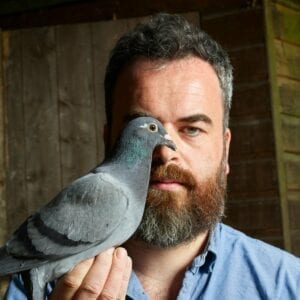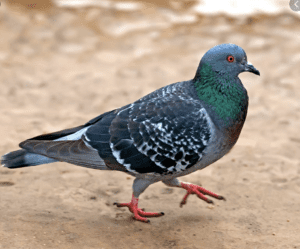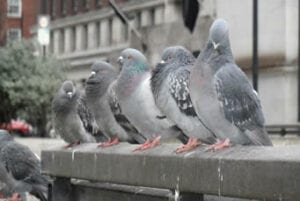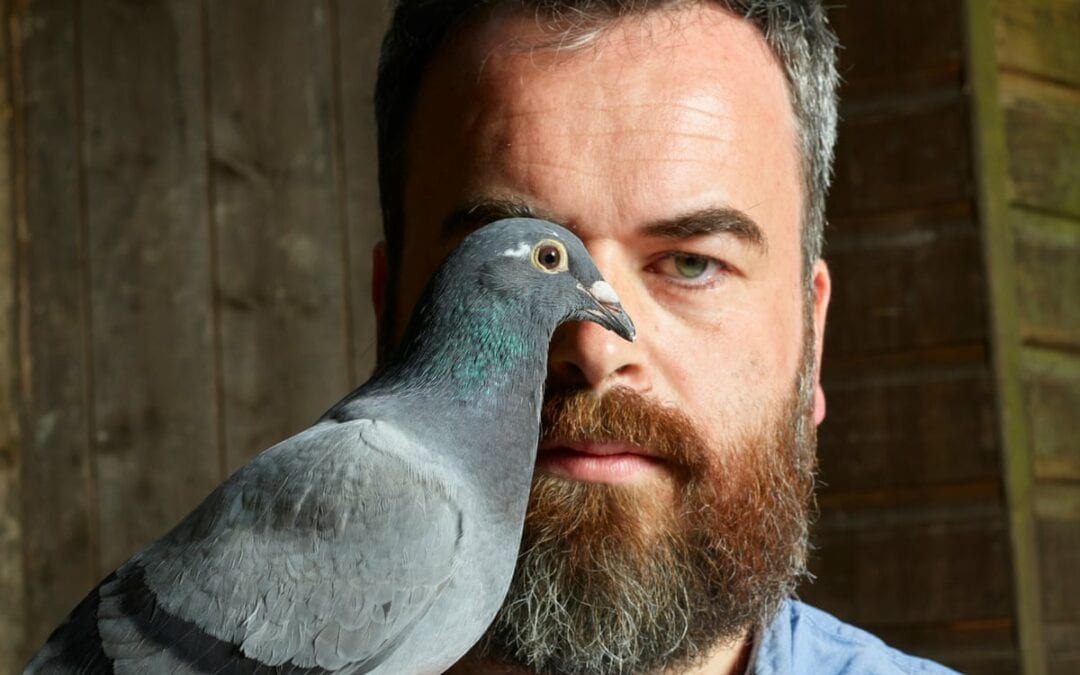
by Pigeon Patrol | Sep 14, 2021 | Pigeon Spikes, Pigeons, Pigeons in the News, Raccoons, Sparrows, UltraSonic Bird Control
New research has shown that feral, untrained pigeons can recognise individual people and are not fooled by a change of clothes.
Researchers, who will be presenting their work at the Society for Experimental Biology Annual Conference in Glasgow on Sunday the 3rd of July, have shown that urban pigeons that have never been caught or handled can recognise individuals, probably by using facial characteristics.
Although pigeons have shown remarkable feats of perception when given training in the lab this is the first research showing similar abilities in untrained feral pigeons.
In a park in Paris city centre, pigeons were fed by two researchers, of similar build and skin colour, wearing different coloured lab coats. One individual simply ignored the pigeons, allowing them to feed while the other was hostile, and chased them away. This was followed by a second session when neither chased away the pigeons.
The experiment, which was repeated several times, showed that pigeons were able to recognise the individuals and continued to avoid the researcher who had chased them away even when they no longer did so. Swapping lab coats during the experiments did not confuse the pigeons and they continued shun the researcher who had been initially hostile.
“It is very likely that the pigeons recognised the researchers by their faces, since the individuals were both female and of a similar age, build and skin colour,” says Dr. Dalila Bovet a co-author of this work from the University of Paris Ouest Nanterre La Défense. “Interestingly, the pigeons, without training, spontaneously used the most relevant characteristics of the individuals (probably facial traits), instead of the lab coats that covered 90% of the body.”
The fact that the pigeons appeared to know that clothing colour was not a good way of telling humans apart suggests that the birds have developed abilities to discriminate between humans in particular. This specialised ability may have come about over the long period of association with humans, from early domestication to many years of living in cities.
Future work will focus on identifying whether pigeons learn that humans often change clothes and so use more stable characteristics for recognition, or if there is a genetic basis for this ability, linked to domestication or to having evolved in an urban environment.
Source
Pigeon Patrol Products & Services is the leading manufacturer and distributor of bird deterrent (control) products in Canada. Pigeon Patrol products have solved pest bird problems in industrial, commercial, and residential settings since 2000, by using safe and humane bird deterrents with only bird and animal friendly solutions. At Pigeon Patrol, we manufacture and offer a variety of bird deterrents, ranging from Ultra-flex Bird Spikes with UV protection, Bird Netting, 4-S Bird Gel and the best Ultrasonic and audible sound devices on the market today.
Voted Best Canadian wholesaler for Bird Deterrent products ten years in a row.
Contact us at 1- 877– 4– NO-BIRD, (604) 585-9279 or visit our website at www.pigeonpatrol.ca
Pigeon/Pigeon Patrol / Pigeons Roosting / Vancouver Pigeon Control /Bird Spikes / Bird Control / Bird Deterrent / Pigeon Deterrent? Surrey Pigeon Control / Pest /Seagull deterrent / Vancouver Pigeon Blog / Birds Inside Home / Pigeons in the cities / Ice Pigeons/ What to do about pigeons/ sparrows , Damage by Sparrows, How To Keep Raccoons Away, Why Are Raccoons Considered Pests/ De-fence / Pigeon Nesting/ Bird Droppings / Pigeon Dropping/ woodpecker control/ Professional Bird Control Company/ Keep The Birds Away/ Birds/rats/ seagull/pigeon/woodpecker/ dove/sparrow/pidgeon control/pidgeon problem/ pidgeon control/flying rats/ pigeon Problems/ bird netting/bird gel/bird spray/bird nails/ bird guard
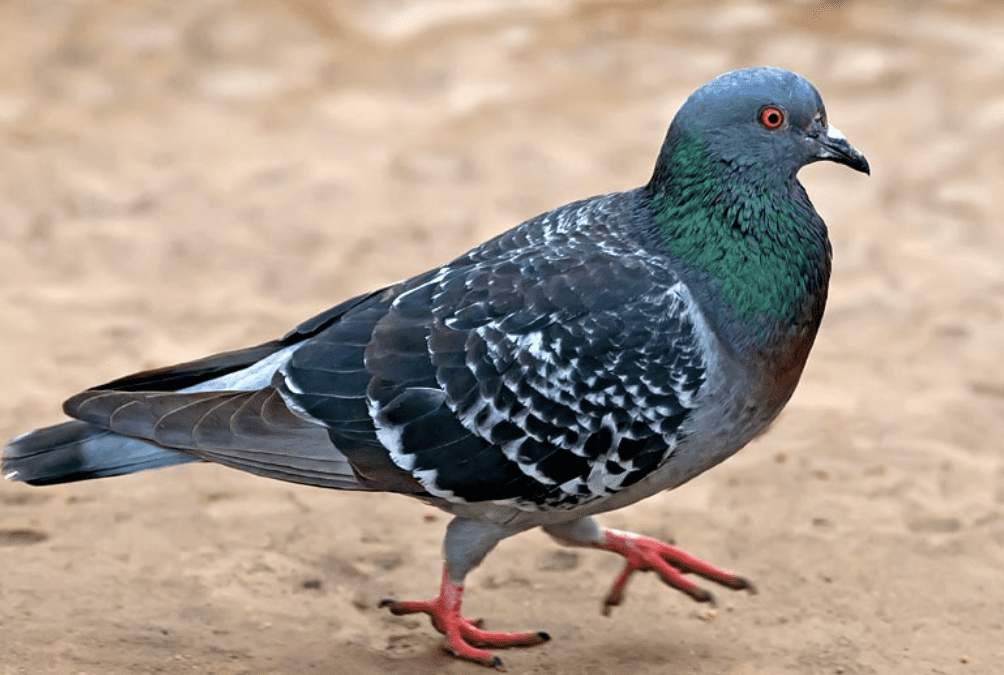
by Pigeon Patrol | Sep 14, 2021 | Pigeon Patrol's Services, Pigeon Predators, Pigeon Spikes, Pigeons, Pigeons in the News, Raccoons, Sparrows, UltraSonic Bird Control
In a rather surprising turn of events, it appears pigeons use their body to make sharp turns, rather than stronger wing strokes when flying. This bit of news comes from Ivo Ros of Harvard University and his colleagues who have been studying the bird’s flight skills with high speed cameras. They have published their results in the Proceedings of the National Academy of Sciences.
Intuitively, it might seem, at least to humans who have no natural wings of course, that to turn, especially when sharp angles are involved, that flailing the wing harder or faster that is opposite the turn would be the most natural way to proceed. After all, that’s the approach us humans would use in water for instance, in trying to turn quickly. But that’s not how birds operate, at least not pigeons. Ros and his team set up nine high-speed synchronized cameras in a hall that had a ninety degree turn in the middle of it. They then marked a pigeon in sixteen places to track just exactly how each body part moved as it flew. They then set the bird to flying the hallway, capturing every detail and noting precisely what goes on with its body, wings, and tail as it turns. Surprisingly, it turned out that the pigeon neither flapped faster or harder, opting instead to simply turn or roll its body to adjust for the turn and allowing its wings to flap as they would were the bird heading straight. Once through the turn, the bird then readjusted its body to enable straight ahead flight.
While all this may not seem all that remarkable, after all, the pigeons have likely been turning in flight for more years than we have held interest in how they do so, the observations may provide important information for people wishing to improve on clunky old human flight, or more specifically, when trying to build drones that can fly better than what is available today.
It’s not hard to imagine the difference. Sending a drone down a narrow hall where it must negotiate a ninety degree turn is quite frankly, impossible at this point, though a helicopter, which perhaps not coincidently turns in ways very similar to the pigeon, could do it with ease. This is because it can slow down without losing lift. But if the drone could be made to maneuver its body as it turns, perhaps then it could perform maneuvers that the common pigeon takes for granted.
Source
Pigeon Patrol Products & Services is the leading manufacturer and distributor of bird deterrent (control) products in Canada. Pigeon Patrol products have solved pest bird problems in industrial, commercial, and residential settings since 2000, by using safe and humane bird deterrents with only bird and animal friendly solutions. At Pigeon Patrol, we manufacture and offer a variety of bird deterrents, ranging from Ultra-flex Bird Spikes with UV protection, Bird Netting, 4-S Bird Gel and the best Ultrasonic and audible sound devices on the market today.
Voted Best Canadian wholesaler for Bird Deterrent products ten years in a row.
Contact us at 1- 877– 4– NO-BIRD, (604) 585-9279 or visit our website at www.pigeonpatrol.ca
Pigeon/Pigeon Patrol / Pigeons Roosting / Vancouver Pigeon Control /Bird Spikes / Bird Control / Bird Deterrent / Pigeon Deterrent? Surrey Pigeon Control / Pest /Seagull deterrent / Vancouver Pigeon Blog / Birds Inside Home / Pigeons in the cities / Ice Pigeons/ What to do about pigeons/ sparrows , Damage by Sparrows, How To Keep Raccoons Away, Why Are Raccoons Considered Pests/ De-fence / Pigeon Nesting/ Bird Droppings / Pigeon Dropping/ woodpecker control/ Professional Bird Control Company/ Keep The Birds Away/ Birds/rats/ seagull/pigeon/woodpecker/ dove/sparrow/pidgeon control/pidgeon problem/ pidgeon control/flying rats/ pigeon Problems/ bird netting/bird gel/bird spray/bird nails/ bird guard

by Pigeon Patrol | Sep 7, 2021 | Pigeon Droppings, Pigeon Patrol's Services, Pigeon Predators, Pigeon Spikes, Pigeons, Pigeons in the News
An animal rights group stopped a planned pigeon shoot over the weekend, leaving the would-be marksmen to shoot down another target: The animal group’s aerial drone.
A group called SHARK, SHowing Animals Respect and Kindness, went to Broxton Bridge Plantation near Ehrhardt, S.C., on Sunday to video a live pigeon shoot, according to the Times and Democrat of Orangeburg, S.C. The group lofted a small Mikrokopter drone and planned to tape the shoot. Law enforcement officers and an attorney tried to stop the drone from flying, according to the T&D. The group persisted, and apparently the shooters got back in their cars to leave, said Steve Hindi, president of SHARK.
The drone took off anyway, and then several shots rang out. One eventually struck the drone and it spiraled to the ground, to the dismay of the SHARK representatives who were filming it from the ground. The T&D has video of it here.

Civilian use of drones is becoming more widespread, with sometimes strange and interesting results. Microdrones, the maker of the drone used in this case, previously unleashed a drone to chase African wildlife to get some new animal footage. Last month an amateur drone pilot spotted a river of blood streaming from a pig slaughter facility in Texas, prompting the Texas Environmental Crimes Task Force to launch an investigation. And paparazzi drones could soon be stalking celebrities.
With new rules governing drones in U.S. airspace taking effect this fall, stories like this could become more common.
Source
Pigeon Patrol Products & Services is the leading manufacturer and distributor of bird deterrent (control) products in Canada. Pigeon Patrol products have solved pest bird problems in industrial, commercial, and residential settings since 2000, by using safe and humane bird deterrents with only bird and animal friendly solutions. At Pigeon Patrol, we manufacture and offer a variety of bird deterrents, ranging from Ultra-flex Bird Spikes with UV protection, Bird Netting, 4-S Bird Gel and the best Ultrasonic and audible sound devices on the market today.
Voted Best Canadian wholesaler for Bird Deterrent products ten years in a row.
Contact us at 1- 877– 4– NO-BIRD, (604) 585-9279 or visit our website at www.pigeonpatrol.ca
Pigeon/Pigeon Patrol / Pigeons Roosting / Vancouver Pigeon Control /Bird Spikes / Bird Control / Bird Deterrent / Pigeon Deterrent? Surrey Pigeon Control / Pest /Seagull deterrent / Vancouver Pigeon Blog / Birds Inside Home / Pigeons in the cities / Ice Pigeons/ What to do about pigeons/ sparrows , Damage by Sparrows, How To Keep Raccoons Away, Why Are Raccoons Considered Pests/ De-fence / Pigeon Nesting/ Bird Droppings / Pigeon Dropping/ woodpecker control/ Professional Bird Control Company/ Keep The Birds Away/ Birds/rats/ seagull/pigeon/woodpecker/ dove/sparrow/pidgeon control/pidgeon problem/ pidgeon control/flying rats/ pigeon Problems/ bird netting/bird gel/bird spray/bird nails/ bird guard
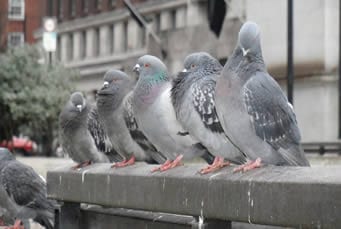
by Pigeon Patrol | Sep 7, 2021 | Pigeon Predators, Pigeon Spikes, Pigeons, Pigeons in the News, Raccoons, Sparrows
BAD AXE — A 24-year-old Pigeon man must spend about three more months in jail for stealing and pawning nearly $20,000 worth of jewelry belonging to a friend’s mother.
Matthew J. Rousse was sentenced to 120 days in the Huron County Jail, with credit for 29 days already served, and two years of probation.
Sentencing was delayed in September when Rousse was receiving in-patient substance abuse treatment, Bay City Times records show.
Rousse pleaded guilty in July to one count of larceny less than $20,000.
From Oct. 1, 2009, to March 5, Rousse took a $2,096 wedding band, a $3,180 diamond ring and various gold chains and charms, investigators said.
He pawned the goods in Saginaw and Bay City, authorities said.
Source
Pigeon Patrol Products & Services is the leading manufacturer and distributor of bird deterrent (control) products in Canada. Pigeon Patrol products have solved pest bird problems in industrial, commercial, and residential settings since 2000, by using safe and humane bird deterrents with only bird and animal friendly solutions. At Pigeon Patrol, we manufacture and offer a variety of bird deterrents, ranging from Ultra-flex Bird Spikes with UV protection, Bird Netting, 4-S Bird Gel and the best Ultrasonic and audible sound devices on the market today.
Voted Best Canadian wholesaler for Bird Deterrent products ten years in a row.
Contact us at 1- 877– 4– NO-BIRD, (604) 585-9279 or visit our website at www.pigeonpatrol.ca
Pigeon/Pigeon Patrol / Pigeons Roosting / Vancouver Pigeon Control /Bird Spikes / Bird Control / Bird Deterrent / Pigeon Deterrent? Surrey Pigeon Control / Pest /Seagull deterrent / Vancouver Pigeon Blog / Birds Inside Home / Pigeons in the cities / Ice Pigeons/ What to do about pigeons/ sparrows , Damage by Sparrows, How To Keep Raccoons Away, Why Are Raccoons Considered Pests/ De-fence / Pigeon Nesting/ Bird Droppings / Pigeon Dropping/ woodpecker control/ Professional Bird Control Company/ Keep The Birds Away/ Birds/rats/ seagull/pigeon/woodpecker/ dove/sparrow/pidgeon control/pidgeon problem/ pidgeon control/flying rats/ pigeon Problems/ bird netting/bird gel/bird spray/bird nails/ bird guard
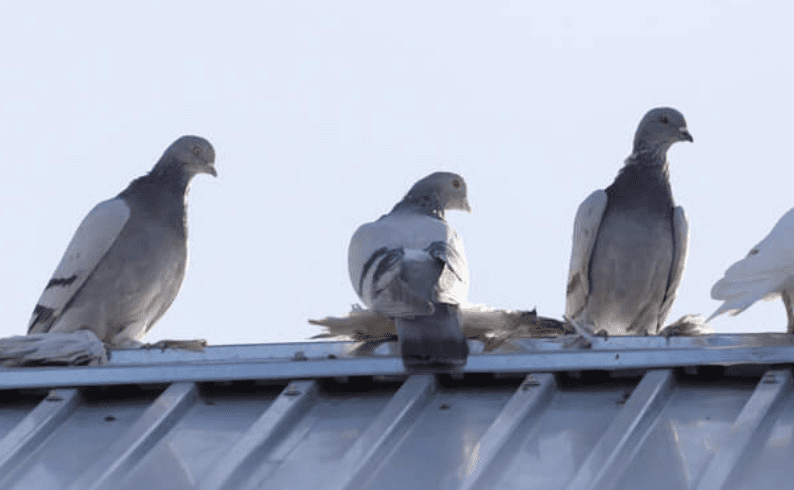
by Pigeon Patrol | Sep 7, 2021 | Pigeon Patrol's Services, Pigeon Predators, Pigeon Spikes, Pigeons, Pigeons in the News, Raccoons
An introduction to pigeon shooting
Managing pigeon numbers through shooting to prevent damage of crops is carried out in different ways at different times of year.
It’s a skill that takes time to learn. Successful pigeon shooting demands fieldcraft, reconnaissance skills and, needless to say, straight shooting.
An estimated 5.4million pairs of woodpigeons now live in the UK.
In 2014, the Government looked at the damage done by pigeons to crops and asked farmers to estimate how much it cost them. They estimated a figure of £75 million for woodpigeon damage to oilseed rape crops alone every year.
Brassicas are also great favourites of pigeons. Experts from the Agriculture and Horticulture Development Board estimated losses for farmers growing crops such cabbage, broccoli and kale to pigeons of between £330 and £1,250 per hectare. Cereal crops are also attacked, particularly when they are mature.
Fenland farmer Richard Gilbert said: “Here in the Fens it’s just a waste of time sowing a field with rape if there are any trees or hedges around the perimeter or power lines crossing the field.”
Types of pigeon shooting
Roosting pigeons
In this form of pigeon shooting the Gun shoots the pigeons as they are returning to the woods where they roost . All it requires is permission from the farmer or landowner, a gun, and cartridges.
The favoured roosting woods for pigeons contain fir trees, surrounded by hardwood trees such as beeches and oaks. The former provides warmth and shelter and the latter can provide food.
Roosting tends to take place at the end of the shooting season, from the end of January until about the end of March. Pigeon shooter and Shooting Times contributor Tom Payne advises: “I roost pigeons from November until the end of March but due to the shooting season most roost shooting doesn’t start until the end of February. The tree branches are still visible then and pheasant shooting has finished. “
Flighting pigeons
In this discipline you are shooting the pigeons as they are going from their roosting position to feed along their chosen flight line, or returning to roost on their way back from feeding.
First of all you need to discover an established pigeon feeding ground. While out of sight, so you don’t disturb any pigeons, watch the birds fly in and out, taking careful note of the lines they are taking. (A pair of binoculars is very helpful here.) Tom Payne advises: “Pigeons are creatures of habit and will follow a line religiously, so to be successful you have got to be close to it or under it.”
Decoying pigeons
Tom Payne: “To decoy pigeons you first have to find their chosen feeding field and then establish how they are getting there. That is your reconnaissance. The fieldcraft part of decoying is putting your hide in the correct place and placing your decoys correctly over their chosen food source.
Pigeon shooters use flappers, magnets and floaters, which are decoys that mimic the behaviour of live pigeons.
Pigeons feed in company. If they spot other pigeons feeding in a field they will come down to investigate the food source, whilst the shooter is obscured out of sight, gun at the ready.
Tom Payne advises: “Being in the right position is the key to being able to decoy pigeons successfully. Being in the wrong position by 40 yards can completely change the way birds react to your decoys. The way I decoy is to represent what I see during my reconnaissance. If birds are feeding in small groups spread apart, I will copy this when I put out my decoys. Birds feed differently on every crop. This is due to the amount and density of food available and the time of year.”
The flightlines of pigeons are not fixed and vary with changes in the wind and food. Pigeons need to adapt to survive, so the lines they follow are never quite the same.
During the winter months birds flock but as they move into the spring and summer months pigeons start to disperse from small groups into singles and pairs.
Decoys tend to work more successfully in the summer months because individual birds or pairs are coming out to feed, rather than flocking. It is easier to shoot individual birds and so harder to decoy during the winter months, when birds are flying together, unless you are shooting in wind conditions which break up the flocks.
What crops to shoot pigeons over and when
Oilseed winter rape, depending on its level of growth, will attract considerable pigeon attention. As you move into the spring months failed or backward rape will attract attention.
In February and March frosted crops such as cabbages, cauliflower and sprouts will attract their attention, as well as early spring clover.
In spring, the pigeon shooter will be focused on controlling pigeons from spring drillings to protect newly sown crops. The experienced shooter will know when the fields are being drilled from conversations with the farmer and will give the pigeons a few days to discover the new drilllings.
By April late spring drillings and peas can bring decent bags. Come June the pigeon shooter will be watching fields of peas or seeds.
Laid cereal crops will attract the attention of pigeons in July.
During harvest time pigeons can be found on almost any harvested crops. During hot weather they may well be discovered on remote drinking areas.
Your geographic location will also dictate when you are most likely to be successful on certain crops. Tom Payne advises: “Certain crops change depending on the weather that year. You could be shooting barley in early June. Follow the agricultural calendar and remember that the harvest is different in Cornwall from Scotland, the south could be a month ahead of the north. Always talk to a local about the conditions.”
How to get a pigeon shooting permission
Your local farmer or landowner will need to have confidence in the person asking for a permission so take the time to get to know them. They aren’t going to let anybody shoot their land unless they trust them. Shooting Times contributor Simon Garnham writes: “If you never ask, you’ll never know…. If the rape is being hammered by pigeons you may be the answer to a food producer’s prayer.”
Tom Payne says that the best time of year to ask for a permission is in the winter, particularly when pigeons are after winter rape. A farmer may be more receptive then as he wants his newly sown crops protected in the coming months.
When you speak to the farmer dress appropriately and don’t wear camouflage. You want to look approachable. It’s always worth writing a letter giving your experience and how you will go about pigeon shooting.
All aspects of the new general licence reviews should be followed and any possible changes adhered to.
You’ll find a full guide to getting pigeon shooting permission here.
Guns and ammunition for pigeon shooting
Use any gun in which you have confidence and which is a good fit. It could be an over-under, side-by-side or semi-automatic. Tom Payne’s favourite cartridge for pigeon shooting is a Hull High Pheasant Extreme 32g No 5 because “they are smooth and hard hitting”.
Shooting Times recently tested steel shot against lead shot for pigeon shooting and discovered that steel performs as well as lead. The shot penetrates deeper because it travels faster, passing straight through the bird rather than remaining within the carcass.
Source
Pigeon Patrol Products & Services is the leading manufacturer and distributor of bird deterrent (control) products in Canada. Pigeon Patrol products have solved pest bird problems in industrial, commercial, and residential settings since 2000, by using safe and humane bird deterrents with only bird and animal friendly solutions. At Pigeon Patrol, we manufacture and offer a variety of bird deterrents, ranging from Ultra-flex Bird Spikes with UV protection, Bird Netting, 4-S Bird Gel and the best Ultrasonic and audible sound devices on the market today.
Voted Best Canadian wholesaler for Bird Deterrent products ten years in a row.
Contact us at 1- 877– 4– NO-BIRD, (604) 585-9279 or visit our website at www.pigeonpatrol.ca
Pigeon/Pigeon Patrol / Pigeons Roosting / Vancouver Pigeon Control /Bird Spikes / Bird Control / Bird Deterrent / Pigeon Deterrent? Surrey Pigeon Control / Pest /Seagull deterrent / Vancouver Pigeon Blog / Birds Inside Home / Pigeons in the cities / Ice Pigeons/ What to do about pigeons/ sparrows , Damage by Sparrows, How To Keep Raccoons Away, Why Are Raccoons Considered Pests/ De-fence / Pigeon Nesting/ Bird Droppings / Pigeon Dropping/ woodpecker control/ Professional Bird Control Company/ Keep The Birds Away/ Birds/rats/ seagull/pigeon/woodpecker/ dove/sparrow/pidgeon control/pidgeon problem/ pidgeon control/flying rats/ pigeon Problems/ bird netting/bird gel/bird spray/bird nails/ bird guard
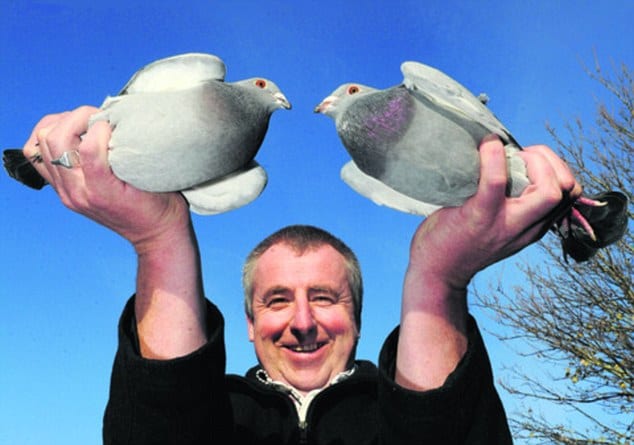
by Pigeon Patrol | Sep 7, 2021 | Pigeon Predators, Pigeon Spikes, Pigeons, Pigeons in the News


